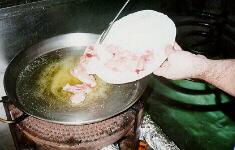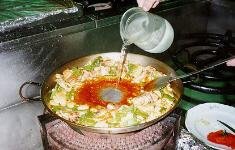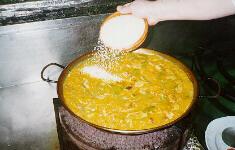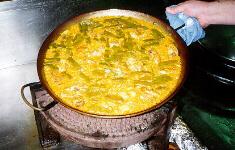 |
|
 |
|
 Bullfighting
is one of the oldest Spanish traditions, maybe one of the most known abroad,
and for sure the most polemic one.
Bullfighting
is one of the oldest Spanish traditions, maybe one of the most known abroad,
and for sure the most polemic one.
However, the "bou al carrer" or "bou per la vila", typical from the Valencian region, is very different from the worldwide known "Corridas de Toros". The first big difference is that, as the name says, the "bou al carrer" -bull in the street- happens within a certain area of the old village -"vila"-, which streets are closed with special barriers to avoid the bull to get out of it. The second difference is that in this "bou al carrer", there is no "torero" nor "matador" fighting versus the bull. All people that wants to run in front -or after- the bull is free to do it, under its own responsability. The first historical reference to "bou al carrer" in Vila-real is dated 1375, although it was limited to the main square "plaça de la Vila".
 The "bou
embolat" is a variation of the "bou al carrer",
although much more recent (seems to start last century). It was then quite
difficult to have a bull running along the streets at night, due to the
poor ilumination before electricity became something so normal as it is
today. Therefore, the solution was to install a special metal device on
the bull's head to support two fire balls that iluminated the street, warning
people about the bull's presence. Today, this light source is not needed
anymore, but tradition continues this way.
The "bou
embolat" is a variation of the "bou al carrer",
although much more recent (seems to start last century). It was then quite
difficult to have a bull running along the streets at night, due to the
poor ilumination before electricity became something so normal as it is
today. Therefore, the solution was to install a special metal device on
the bull's head to support two fire balls that iluminated the street, warning
people about the bull's presence. Today, this light source is not needed
anymore, but tradition continues this way.
Normally, the same bull or bulls that were runned during the day are "balled" at night. At the end of the run -two hours or so- the bull is sacrified by a professional butcher and the meat sold, after passing all the correct sanitary controls.
The Mothers Clarisas manufacture a small string which Saint Pascual Baylon devots wear around wrists and ankles. These strings are passed on the Saint sepulchre once they are finished, being what gives them its special value for believing persons. However, today these small cords, which are exported to other countries, are made due to the demand even with the colours of football teams.
extracted from Discover Spain with the Tourist Office of Spain
"If there is one dish that represents our area, throughout the Community of Valencia, then that is rice. Rice dishes come in a great many different varieties, ranging from the universally known Valencian paella to "arroz abanda".
Arroz abanda, which in fact is two dishes, really constitutes a complete meal. On the one hand it is a kind of special paella, in which the broth which forms its base is produced from all kinds of fish. The latter appears in another dish but not with the rice itself. The most typical fish used is a good sized sea bass, although there are many other similar kinds that are also possible. This is then served with potatoes and a special sauce known as all-i-oli (garlic and olive oil) which complements the rice dish. It is not a meal for the fainthearted.
Other typical rice dishes include Valencian paella, with chicken, rabbit and plenty of green vegetables (and optionally some white snails known locally as "baquetes"); arroz al horno (baked rice) with blood sausage and pieces of pork; and "Empedrat". Rice goes well with practically everything, and "Empedrat" is a rice dish with cod and beans which is enough to make anyone's mouth water.
Most restaurants offer a wide choice of rice dishes, as well as most national and international dishes. Then there are also the tapas (hors d'oeuvres) on offer in bars and the like. Eating on basis of small quantities of a variety of foods is easy, quick and convenient. These tapas might well take the form of fried fish, grilled cuttlefish, squid a la romana (fried in egg and flour), blood sausage, prawns in garlic, grilled sardines, steamed mussels or perhaps in a sauce, snails, Spanish potato omelette, kidneys, monkfish, cod croquettes, meatballs, tripe, pig's trotters, fried anchovies or in vinegar. This list includes just some of the snacks available at may bars that can help to put one on until the next meal. "
written by José Martínez from the US, to whom I agree in his recipe, photos added by myself
Valencian paella is perhaps one of the most controversial courses made in Spain. Original from Valencia (as you may have already guessed!), it has traditionally been a must for most of its population's diet. As far as I recall, my family has eaten paella every single Sunday. I still remember my mother trying and cooking some alternative courses, and the rest of us (especially my father) showing a mix of anger and unpleasant resignation in our faces, evident enough to let her know what that was about.
It is supposed to be made following a rather strict procedure, yet there are many paella-like rice recipes all across Spain that have little to do with our understanding of it, and that in many cases make us jump when we see such inventions being served to some unaware pink-toasted tourist.
Paella's recipe has been the source of many bitter discussions, believe it or not. In one occasion, we even brought a case to the Valencian Parliament, about whether we should use bell peppers or not in it.
Despite living in the US, thousands of kilometres away from home, I still proudly make and eat paella every Sunday. I have sent this recipe to David Koufaty in the hope that you will enjoy this 1st-prize course. I expect some critic messages from other connoisseurs (I think every Valencian feels a little bit like it when it comes to talking about paella), which I will gladly read and, eventually, reply. However, this recipe is the result of attending to and enjoying many paella makings by many cookers, so chances are that many Valencians will agree.
Although there are two basic flavours of paella, meat or fish, many of us think that the real, real one is the former. The meat used for it is either chicken, or rabbit, or both. For those not very keen on strong meat flavours, I recommend chicken. Rabbit is delicious, but it may be difficult to obtain in the US, anyway. Here are the ingredients, or their substitutes had I not been able to locate the exact element:

Despite many opinions, I shall say that paella is a no-garlic, no-onion, no-pea, no-snail, no-bell-pepper, no-mussel course.
A key thing is the recipient in which you are going to cook. ("paella" in Valencian means pan). Generally speaking, the shallower the better. Thick rice cookings are difficult to manage and the rice is not steamed homogeneously, so try and use a container such that your paella does not grow beyond 7-8cm height. My experience tells me that a big pan is fine for 3 people. I have never dared with 4, but you may want to give it a try; in that case I usually cook two paellas in parallel (which in turn impresses my guests!).
You need to put the Lima beans into water overnight, don't forget it. If you do, you can still boil them twenty minutes before beginning to cook, but they will not have such a nice aspect.


Heat olive oil to medium-high temperature,so it barely covers the bottom of the pan. Excess of oil makes the course pretty heavy. The best adviser is experience. Usually olive oil spreads as it warms up, so be conservative.
Clean the chicken, try and remove as much fat as possible, but unless you really dislike it, leave the skin: it gives a nice flavour to the course. Salt and start frying the chicken.
Meanwhile, wash the vegetables and split all green beans. Dice the tomatoes into tiny pieces: you should not see any tomato chunk in a paella serving. Salt the vegetables and turn the chicken over.
Prepare a recipient with fresh water. The rule here varies very much depending on cooking styles. I usually reserve 300cc of water per person.
When the chicken has turned into a golden colour, take the pan half way out of the range and put the chicken in the cold side. It doesn't really matter if you don't do it, but it eases the roasting of the vegetables. In Valencia we use really wide containers, and the oil is in the centre, so we move the chicken to the periphery and continue in the middle with the vegetables.


Put the green beans and the Lima beans in the oil and fry them for four or five minutes, stirring occasionally. Then add the paprika and stir again. Fry for 20-30 seconds and then add the tomato. If you fry the paprika for too long you will ruin it. The water the tomato contains will cool down the oil enough to stop the process. Stir for a minute, then put the pan back in its original position and mix everything. Then add the water.
Use a wooden stick to touch the bottom of the pan and measure the height of the water. You will need it later. In Valencia we don't need such a stick, since our pans have nails on the inside that indicate where the water is supposed to reach (there are different pan sizes for different amount of guests).
Let boil for twenty minutes. Then take the pan out of the range (but don't turn it off). Add water until you get back to the same height: use the wooden stick for this delicate operation. Then put it back to the range. Add salt and let it boil.


As soon as it starts boiling, use a spoon to taste the water. It is important to take the water from the bubbles: it's the only part of the water's surface with no oil. Taste for salt. Add if necessary. Don't be slow in this, you want to add the rice before too much water evaporates. Then add the saffron.
Now, add the rice, 100cc per person. If you want to add more, my rule of thumb is: always 3 times the amount of rice in water. Remember, however, that you want to keep it shallow, 7-8cm. Many others use twice as much water as rice instead, but then times are different. I shall trust my granny on this.
Shake the pan slightly to spread the rice, and let the water boil again. Boil for ten minutes, and then lower the temperature of the range, and let it boil for another ten minutes.
Experience in this crucial process is the best adviser. Ranges behave differently, waters have different compositions, so you might want to play a little by shifting that lower-temperature time point to sooner or later. The total time cooking the rice, however, should still be twenty minutes. In my particular case, 8-12 gives good results. We will call it the switching point.
Whilst the rice is being cooked at its final stage, and when you have no longer a water layer covering the rice, put a couple pieces of rosemary on top of the rice. The steam coming out will activate the scent of the rosemary, which will bathe the paella. Typically this happens in the last five minutes.

If you are an excellent chef, that paella is almost ready: simply take it out of the range and cover it for a couple minutes to concentrate the rosemary scent and maybe soften those last rebel rice grains. However, it is not rare to find that the rice is a little undercooked. Knowing that next time you will have to shift the switching point slightly backwards, this time simply lower the temperature again and cover. The rice loses a little bit of presence, but it will still be delicious.
Finally, many people like to squeeze some lemon over their course. I personally love it, and it is especially advisable when you have used no rosemary.
I hope you enjoy this fantastic piece of Valencia's culture. Your comments will be appreciated."
 This sport (Valencian
ball) is played since really old times. It has several variations,
but for you to understand it, it is something like tennis played with the
hands, using a much harder ball, and on the street or in a special field
called "trinquet". Assistants to the games normally bet for one
or the other player. There is a league in which teams from all over the
Valencian Community play.
This sport (Valencian
ball) is played since really old times. It has several variations,
but for you to understand it, it is something like tennis played with the
hands, using a much harder ball, and on the street or in a special field
called "trinquet". Assistants to the games normally bet for one
or the other player. There is a league in which teams from all over the
Valencian Community play.
 |
|